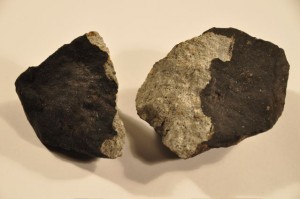The Natural History Museum in Oslo put out a call this week for what its curator feared was a missing meteorite that hadn’t been seen since its publicized landing in the Norwegian capital earlier this year. The museum’s mystery was quickly solved when the meteorite was found in the hands of the country’s most high-profile astronomer, but the museum curator was far from relieved.

Knut Jørgen Røed Ødegaard, a celebrity astrophysicist in Norway, revealed that he bought the meteorite along with his wife, Anne Mette Sannes, from the anonymous person who found it at Grefsen in Oslo last spring. Sannes said the finder wanted to give the couple the meteorite as a gift, “but we chose to say ‘no,'” adding that the couple bought it instead through their commercial venture Sannes & Ødegaards Univers AS.
Ødegaard said it was the best way to ensure that the meteorite, potentially valuable to collectors, “wouldn’t be split up or land in other private hands.” The meteorite, already smashed on landing but weighing 4.65 kilos in total, is said to be the largest found in Norway for more than 100 years. Ødegard won’t say what they paid for it, but museum officials have claimed it may be worth as much as NOK 100,000 (around USD 17,000).
They apparently had overlooked an e-mail sent to them by Ødegaard earlier this month informing them of the purchase, and museum curator Rune Selbekk is not at all happy about it. He thinks meteorites found in Norway should remain in the public domain after first crashing into it.

“I believe this meteorite should be used in connection with research, and put on display at a museum that has the most national competence with meteorites,” Selbekk told Norwegian Broadcasting (NRK). That, in his opinion, would be the Natural History Museum (Naturhistorisk museum) where he works in Oslo.
It was Selbekk who had put out the call for the meteorite in a press release earlier this week. He did not seem abashed when finding out the next day that his own director had received Ødegaard’s e-mail, which simply hadn’t been passed on.
Far from being happy that the meteor was located, Selbekk says he remains “skeptical” towards Sannes’ and Ødegaard’s purchase. He’s disappointed his museum didn’t get a chance to bid on it first, adding that “we should have it in our collection,” which already contains 14 of 15 meteorites found in Norway before the most recent downpour earlier this year when several were found in and around Oslo.
Selbekk is even proposing a law that would secure museums first right of purchase on future finds. “We still hope this meteorite can come to the Natural History Museum,” he told NRK.
That now seems unlikely but Ødegaard, long tied to the University of Oslo as is the museum, told NRK that Selbekk shouldn’t be worried about the meteorite’s fate.
“For one thing, we’re taking good care of it,” he told NRK. “We’ll exhibit it to the public in various astronomy shows and appearances we’ll be making around the country this autumn.”
Both Ødegaard and Sannes also suggest the meteorite might wind up in a museum after all, but they’re leaning towards museums in Bergen or Tromsø instead of Oslo. It already received another meteorite that fell over Rodeløkka in Oslo, also last spring.
“It would be nice if some other museums in the country could get part of the meteorites so that other folks in Norway can see them without having to travel to the capital.” Ødegaard said.
Views and News from Norway/Nina Berglund
Please support our news service. Readers in Norway can use our donor account. Our international readers can click on our “Donate” button:

